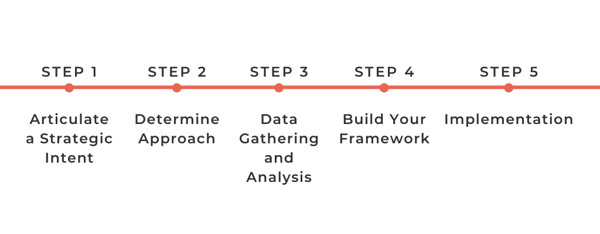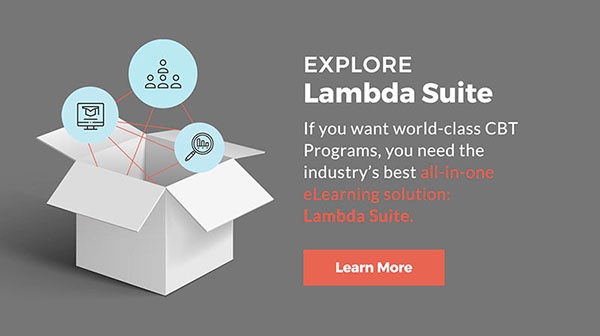Don’t trust anyone who says that defining core competencies is easy. It’s hard. Put in the time, however, and you can expect to see everything from onboarding to executive strategy become more aligned and effective. Here’s how to develop a competency-based approach for your organization.
In 2016, a whole province of Canada transitioned to a new curriculum, which they believed better-prepared students for today’s technological world of constant change and instant information. What did they shift to? Core competencies—an approach leveraged by some of the most successful and industry-defining organizations of the last few decades.
What Are Core Competencies?
In one sense, they’re a learning tool: things over and above a specific skill or knowledge base, which separate experts from trainees. But they’re also an effective business framework: that alchemized thing your organization does better than anyone else.
If people know what competencies are (and many don’t), there’s a fair chance they’ll associate competency development with difficult conversations, organizational soul-searching, and L&D overhauls. And that reputation is partly true—a competencies framework can be tough to create and signal big changes to internal operations. So why are many companies and a whole province of schools doing something that’s likely to cost you time, resources, and a couple of grey hairs?
Adapting to the New Normal
Twentieth-century workforces were, generally speaking, highly static. Career progression was vertical, with those at the top of their particular ladder being (ideally) the best person to handle a particular task. Hiring was equally specific, with job descriptions listing narrowly defined skillsets. Markets were expected to remain predictable, and technology to progress slowly and linearly.

Skip to today, and you’ll find not only people but entire organizations developing laterally, seemingly able to hop industries and navigate literal global pandemics without breaking a sweat. How do they do it? Part of their success is due to fully adopting a competency mindset. While many still operate under a hangover of twentieth-century career Learning and Development, these guys plan and hire according to a set of core organizational competencies—pivoting around that core as necessary when the landscape shifts.
Of course, there are competency evangelists to be found in most organizations. But many still stand to gain from integrating a more fundamental competency-based approach. With that in mind, here are some insights from Lambda’s industry experts on the whys and hows of bringing competencies into training and evaluation.
Navigate This Article
- Part One: Defining Competencies
- Part Two: Why Organizations Use Them
- Part Three: Understanding YOUR Core Competencies
|
Key Point: Why introduce competencies to my workforce? Today’s work environment is more fluid than ever, which makes it ‘survival of the adaptable’ for organizations and employees alike. Moving from a skill-based to a competency-based perspective makes your team better able to respond to challenges, take on new responsibilities, and find alignment between their work and company goals. In turn, this should lead to increases in engagement and motivation for success! |
Part One: Defining Competencies
Back in the ’90s, C.K. Prahalad and Gary Hamel wrote an HBR article that introduced competencies to the mainstream workforce. They claimed that “During the 1980s, top executives were judged on their ability to restructure, declutter, and de-layer their corporations. In the 1990s, they’ll be judged on their ability to identify, cultivate, and exploit the core competencies that make growth possible—indeed, they’ll have to rethink the concept of the corporation itself.”

Their words are still relevant today. In fact, they’re arguably more crucial than ever. Prahalad and Hamel likely had the fast encroaching digital revolution in the back of their heads while making their argument for competency frameworks, and two decades into the age of startups and digital economies, that need has not diminished one bit.
Competencies and Skills
At their base level, competencies are collections of skills, with some knowledge and experience thrown in. But competencies and skills aren’t exactly the same thing.
Skills are the what in task completion. They are usually base level actions developed according to specific methods and implemented in specific situations and settings. So, think coding, running spreadsheets, hiring, or firing. The skill of a golf swing has a certain learning pathway and is applied at the golf course on weekends.
Competencies are the how. This makes them a broader concept, combining skill with knowledge, experience, and behaviour. How a person is able to perform their role is due to a set of competencies, not specific skills. As such, competencies can be built over a career, or whole lifetime—the concepts of ‘wisdom’ or ‘know-how’ may apply.

The skill of a golf swing is important for playing golf, but the sport requires competencies over and above sheer technical prowess: strategy, fitness, patience, discipline, and the ability to lose graciously… just me? Ok.
Core Competencies Definition:
Strategist Christoper Penn defines core competencies as those competencies that “provide access to markets...provide the value behind end-product benefits…[and] provide unique attributes difficult for competitors to imitate.” Many in the competency community split these into organizational and individual competencies:
Organizational core competencies are the things through which an organization is able to deliver on its aims. They don’t all have to be groundbreaking workflows, but ideally, at least one core organizational competencies will be unique to your business.
Here, we’re talking competencies such as:
- Best-in-class customer service
- Technology leadership
- Thought leadership
- Innovation
- Luxury or value options
- Ingenious solutions
Individual competencies use the same premise, scaled down to individual team members—the technical abilities, behaviours, and dispositions that allow people to contribute to overall organizational competencies.
Here, there should be a good mix of hard skills and knowledge with more slippery abilities like instinct, ethics, and compatibility. While such competencies can be hard to define in a measurable way, it’s these soft skills that help make competencies more flexible and adaptable than traditional certifications.
What are the core individual competencies Lambda Solutions believes are most often crucial to L&D success? We’d go for communication, thinking, and personal and social competencies. Here’s our argument: 3 Core Competencies Your HR Must Have For Successful L&D.
Part Two: Why Organizations Use Them
HR software expert HSRG says that defining core competencies is a great way to identify those behaviours and processes that are key to organizational success. When you know the organizational competencies that are the priority, a strong case can be argued for any workflow, technological, or cultural changes that need to take place in order to one-up the competition.
Training: A Transparent Success Framework
Because they create an objective basis for evaluating performance, competencies encourage a more collaborative and transparent approach to learning and development. When everyone has clarity on the most prized tasks and processes inside an organization, people tend to feel more able to take on individual challenges.

That common language of success is only good news for efficiency and innovation. When focusing on competencies, teams are able to quickly align themselves with wider priorities, while individuals can get to work, using their personal expertise to refine the pathway to competency completion.
Let’s take a look at what goes into developing a competency framework for a team, department, or whole organization. For an overview of competency development inside a training course, here’s our free eBook—Compliance and Competency Training Made Easy with LMS.
Competency Development
Whatever you’re developing competencies for, Prahalad and Hamel’s original article advises covering three bases. Competencies should be things that:
(1) make roles or organizations unique
(2) play a role in delivering end value, and
(3) open up possibilities or increase flexibility.
Alongside organizational competencies, individual competency frameworks should be developed for all levels throughout the organization. According to Kent State and many others, there are five generally steps in any framework development process: Step One: Articulate a Strategic Intent.
Step One: Articulate a Strategic Intent.
It all begins with understanding purpose—defining what a role, training program, or organization is aiming to achieve, and then considering which general sorts of competence are relevant.
One method Prahalad and Hamel recommend to discover these areas is to undertake an exercise to define your organization's central offer within its markets. They use the company NEC as an example, phrasing their central goal as “exploiting the convergence of computing and communications.”
Step one is also the time to determine the scope of your framework, if you haven’t already. You’ll want to know how specific or far ranging competencies should be, because competencies are at their best when their achievement feels personal and relevant.
Step Two: Determine Approach.
With intentions clarified, step two is about planning. What people, processes, and data will you need to build your competencies, and the framework itself? Whether developing role-specific competencies or a framework for an entire company, useful development requires collecting real information on internal behaviours and processes that hold the key to understanding the value of your organization.
This isn’t something that’s likely to be achieved with a one-minute email survey on employee satisfaction. The more that can be done to enlist and engage stakeholders across the spectrum of your workplace, the better. Prahalad and Hamel recommend asking questions that target central business intentions, such as “How long could we dominate our business if we didn’t control [our] competency? What future opportunities would we lose without it?”
Step Three: Data Gathering and Analysis.
After two extensive planning stages, step three is the time to dive into data collection, building up the information that will then be evaluated and translated into competencies. According to Kent State, data collection should be double-headed, including:
- Specific case studies and examples of behaviours, projects, or processes that you believe closely align with core competencies (so, the things you’d like to see more of), and,
- The key tasks and Learning and Development objectives of each role to be included in the framework.
Competency Frameworks in Practice (Case Study)
Lambda Solutions partnered with TRIEC to increase the flexibility and adaptability of their reporting and program evaluation process. Using Lambda Suite, TRIEC were able to re-frame their L&D evaluation and reporting around their core competency: enabling newcomers to Toronto to succeed in more diverse labour markets. One month into adopting a competency-based approach, TRIEC recorded a 75% reduction in administrative time spent on reporting, plus a substantial improvement in report accuracy and readability. Read the full case study here: Reduce Admin Time and Provide More Effective and In-demand Resources to HR Professionals. |
Step Four: Build Your Framework.
The final two steps are allocated for the actual implementation of competencies, with step four as the time to identify and categorize all competencies, and step five as the time to apply them. the competency by name and defines the behaviours that are associated with it.
Kent state recommends an approach that either looks to collate all relevant data into a predetermined number of buckets, or if clear competencies are already emerging, then applying measurement scales to clarify ideal, acceptable, and unacceptable (failed) responses to competencies.
Don’t forget: there may also be a place for negative statements, i.e. competency definitions that define roles and organizations by what they intentionally don’t do.
Step Five: Implementation.
Successful transition to a competency-based perspective required a lot of carefully thought-out communication. Teams and stakeholders need to know what’s happening, why it’s happening, and how they will interface with the competencies relevant to them.
Alongside a lengthy communications plan, step five should bring in any technologies needed to implement a competency framework (such as Lambda Learn), as well as necessary training and support to ensure all teams are able to make best use of new systems.
Finally, full implementation also puts in place succession planning to feed the roots of next-generation competencies. For example, budgets might reflect a commitment to yearly reviews of competency relevance, or eLearning might now include space for learners to reflect on the parallels between their training and core competencies.
 Summary of the 5 steps of the framework development process.
Summary of the 5 steps of the framework development process.
In this way, core competencies are a long-term framework, which operates over and above any current or current business processes. This helps pave the way for future leadership opportunities and better training. Here’s our take on 7 Easy Steps for Business Succession Planning Success.
Part Three: Understanding YOUR Core Competencies
Prahalad and Hamel recommend thinking of a diversified company as a tree—the trunk as core products, branches as business units, and leaves and fruit as the end products. The root system, which fuels all other aspects, is an organization's core competencies.

I’m not sure how useful that metaphor is, especially for smaller businesses, but there’s no doubt that focusing on core competencies creates unique, integrated systems that reinforce unity-of-vision, no matter how diverse processes or products get.
Core competency development is about locating those unifying roots—those elements that make a team-role valuable, no matter how business evolves. Or that workplace principle that will always define your organization, no matter how the competitive landscape shifts.
Core Competencies and Business Strategy
An article from Thinkwise recommends viewing strategy as a confluence of three key elements:
- Your organization’s overall mission and vision,
- The teams and individuals working towards that vision, and
- The competencies that will facilitate employees in realizing mission or vision.

These elements highlight the benefit of competency frameworks to business strategy: even when only used as part of training, competencies act as waypoints, keeping activities within an area that contributes most to top-end goals.
The behaviours and models that fall within those waypoints will differ for every organization—which is why the first three stages in the five-step framework are devoted to extensive research and data analysis.
So, What Are Your Organization’s Core Competencies?
Truly understanding your organization’s core competency can make you less vulnerable to external trends and downturns. It’s a kind of clarity that keeps you afloat in stormy seas.

Returning to Christopher Penn's article, he identifies Netflix as a paradigmatic example of a company who found their success in a tough market by pivoting around their core competency: convenient and accessible content. By staying true to their competencies and skills, Netflix were able to surf the transition from DVDs and storefronts to streaming and the digital economy.
Remember: no matter their scope or purpose, the most useful competencies are those that are unique to your organization. And while uniqueness is not necessarily an easy characteristic to come by, any role or process that adds value is likely to contain some kernel of unique benefit.
To find those kernels, you may need to enlist help. So spend time researching competitors, surveying customers/learners, and opening up the floor to staff, in order to discover what competencies the skills, knowledge-base, and goals of your organization could, and should, amount to.
Looking for a Next Step? For more on competencies, here’s our practical webinar on Why You Should Be Running Your L&D Team Like A Startup. Featuring insights from our industry experts, this installment looks at how a competency-based approach helps teams sync with your organization's mission, as well as how to incorporate Build, Measure, Learn loops, so learning and development can stay relevant in an ever-changing environment.
For more advice, best-practices, and how-to guides to creating, implementing, and improving your Learning and Development programs, we have all of these additional resources:
- eBook: Big Data for HR: How Predictive Analytics Can Deliver Business Value
- eBook: Compliance and Competency Training Made Easy with LMS
- Case Study: Reduce Admin Time and Provide More Effective and In-demand Resources to HR Professionals
- Article: 3 Core Competencies Your HR Must Have For Successful L&D
- Article: 7 Easy Steps for Business Succession Planning Success
- Webinar: Why You Should Be Running Your L&D Team Like A Startup
- Webinar: Faster, Better, Easier User Management With Totara HR Import
- Webinar: How to Make Compliance Simple Yet Effective
- Webinar: Ability and Appliance - Using Competency and Compliance for Moodle
- Webinar: Ability and Appliance - Using Competency and Compliance for Totara





 Toronto Region Immigrant Employment Council (TRIEC) provides resources to help HR and Diversity and Inclusion professionals build more inclusive workplaces.
Toronto Region Immigrant Employment Council (TRIEC) provides resources to help HR and Diversity and Inclusion professionals build more inclusive workplaces.
